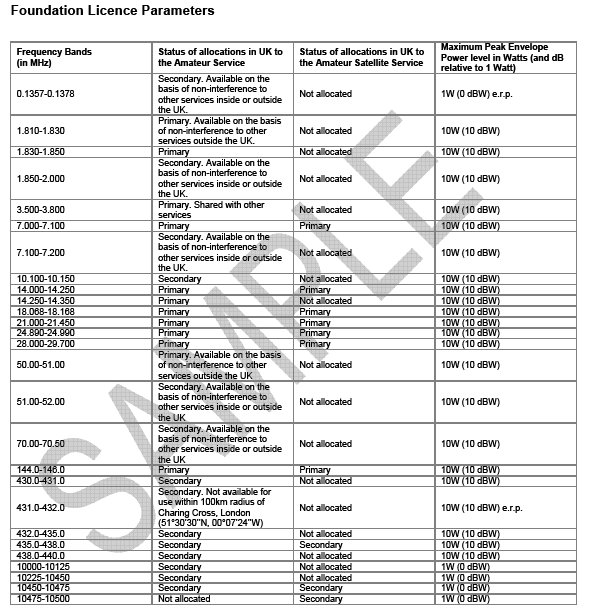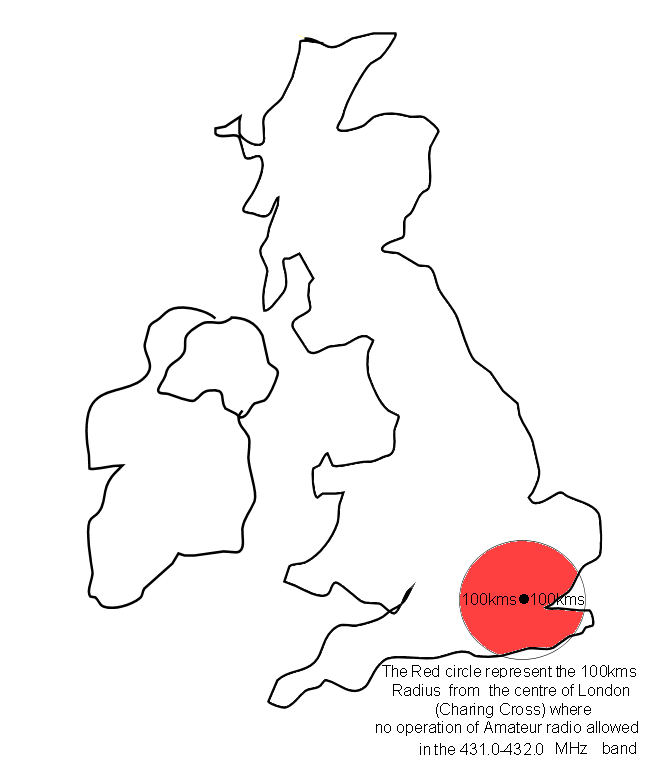



| |
Section 1 --- Licence Conditions and Station Identification
Licence Schedules
1G1 Q5 Identify relevant
information in the Schedule 1 to the Foundation licence.
A copy of the relevant part of Schedule 1 will be available during
the examination.
In the licence schedule, laid out in tables with frequency bands, Foundation licence holders use only Table A in their exam. The first question in this section may ask you to look up something in the schedule.
Below you will find an old schedule to the Amateur Life time licence as it applies to the Foundation Licence.
So please down load the latest version of Schedule 1 as
on the RSGB WEB SITE from this link
Particularly take note of what is in the notes as they too are part of Schedule 1
You must understand the schedule and know how to apply it when operating. Answering these two questions you need to look at the sheet provided, which should give you two certain marks.
Column 1
There are several columns the most important of which is the first one Frequency Bands in MHz. This sets out which frequencies you may operate and also indicate what are the band edges of the frequencies.
For instance 51.00-52.00 indicates you may operate between those frequencies. All the frequencies as shown at the top of the sheet are in MHz.
Column 2
The status in the UK of the amateur service. This means whether amateur radio is the primary user or preferred user of that segment or if amateur radio is a secondary user meaning that if another legitimate transmitter is operating on that frequency then it must continue unimpeded.
Column 3
This shows the status of the amateur Satellite Service which is of interest to Foundation licence holders as they now appear to be allocated the status to operate on certain bands.
Column 4
The second most important column as it states the amount of power that can be radiated. Note ERP applies in some cases. You will learn more about that in a later section (Feeder and Antenna) about half way down the page.

It is likely there will be one question from the VHF section of the schedule in the exam.
It is important that students read and learn all the terms and conditions and notes as set out in section 2 of the Amateur Licence.
There is thus the need to understand the schedule and be ably to apply the information to operating practice.
In the exam you are provided with a sheet headed up Foundation licence Parameters. The details all the frequencies upon which you when a Foundation Licence holder you are permitted to operate. Any frequency which may be quoted on the exam paper outside those printed you are not permitted to use.
If a frequency or frequency band is quoted in an exam question but it is not indicated on the Foundation Licence Parameter Sheet that you will have available to you in the examination, then you cannot operate in the suggested frequency.

Please note that the graphic is to emphasise that fact
that no transmitting on the 431.0 - 432.0 MHz is permitted within 100kms
radius of the centre of London, indicated at Charing Cross in the paper
work you will receive in the examination.
One item that is not covered in the paper work would be the answer to this question.
The recommended power needed to establish communications on the 144-146MHz is ?
a. The lowest possible
b. 10dBW
c. 5W
d. 1W
Whilst the paperwork indicates the maximum power you may use it does not tell you that you should try to use the lowest possible power level to establish and to continue communication.
So the correct answer would be (a.) The lowest possible
The same applies to operating all modes and all bands.
1G2
Recall the:
Please read the OFCOM document "Guidance on EMF Compliance and Enforcement." A summary can be found on the RSGB web site here:
Compliance with ICNIRP Exposure Guidelines. We generate electromagnetic fields (EMF)when we transmit which can be dangerous to our health. Transmitting at powers higher than 10 Watts EIRP or 6.1 Watts ERP, we can be exceeding the safety limit set out by OFCOM.ICNRP is the International Commission for Non-Ionizing Radiation Protection which which sets the safety levels. These limits are known as "general public EMF limits".
EIRP stands for Equivalent Isotropically Radiated Power. It is a measure of the strongest power emitted in a given direction from an antenna.
ERP stands for Effective Radiated Power - the product of the power supplied to an antenna and its gain in a given direction relative to a half-wave dipole. You will understand more about these terms as you progress through your learning.
Your EMF Assessment
Therefore all licenced amateurs are duty bound to comply with these regulations that apply to the safety of the general public on both private and public property. It has been made easy to calculate the EMF levels from your aerial by using OFCOM's EMF calculator, and you can also find a version at the RSGB web site. You can then work out, for each band that you can transmit on, the safe distance from the aerial. Should a member of the general public have near access to your aerial and the EMF is found to be outside the recommended safe levels, then you could reduce your power until the safety level is reached, or increase the height or moving the aerial may help comply with the higher power level. You may have to put up safety signs or barriers. There are other ways to comply too. You need to calculate and keep a record for each band and each aerial. These records may be examined if an OFCOM officer visits your station. They may even make routine compliance checks. Re-assessments need to be taken if you change the transmitter or the aerial, the record of your assessments must be dated.
Note:
1. The main health effect of exposure to electromagnetic radiation is heating of body tissue and that the eyes are particularly susceptible to damage.
2. The record includes a justification of why no further action is required if that is the case (e.g., power levels are below the threshold)
The origin of some of the text on this page is from the RSGB with additions by the web master